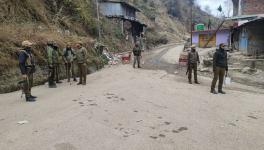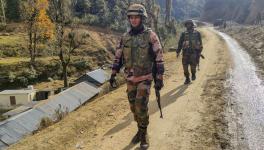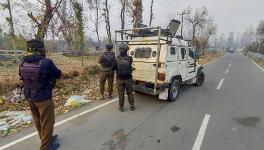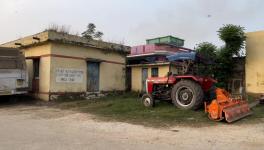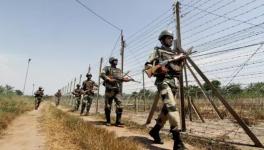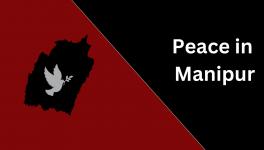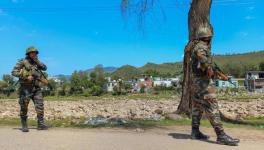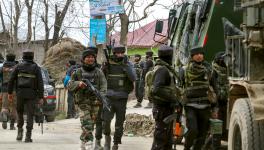Why Do Kashmiris Keep Fighting the Indian Army?
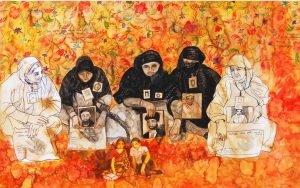
An unnamed youth — one among the 25 injured in Darbugh village, near Chadooora town in the district of Budgam, in Kashmir; where three civilians also lost their lives to the bullets fired by the Indian government’s forces on 28th March 2017 — answered a question posed by a reporter as to why he threw stones during military operations. He said, “I had come to help the militant escape. He (militant) had taken up gun, and I picked up stones, to fight oppression.”
The answer encapsulates a widely shared view among young Kashmiri men and women today. India’s army chief, Bipin Rawat, issued a public statement on 15 February, 2017 in which he warned Kashmiris that those among them who “create hurdles during (Army) operations” will face “harsh action.” By calling them “over-ground workers of terrorists” and equating stone-pelting, and flag-waiving of Pakistan and ISIS banners, as acts of “terrorism” carried out by “anti-nationals,” he was, essentially, justifying the increase in blood-letting, and also widening the net of the military crackdowns to include civilians. Equating civilians with terrorists is a common practice among nation-states waging wars outside their borders or at home. The Indian policy towards armed militants since 1989–90, when the Kashmir insurgency began, was captured pithily in the movie Haider, which carried a scene in which a graffiti on the military barrack walls reads, “Catch them by the balls and their hearts and mind will follow.”
The 15 February, 2017 statement by the Army chief came in the wake of two incidents, one on 12th February, 2017, and another one on 14 February, 2017. In both the incidents, people not only gathered to protest the killing of militants in an encounter, but the funeral thereafter of the four dead militants saw a mass gathering of people. The fact that people were defying the Indian army, the fourth largest in the world, and extending support to the militants, is yet another reminder that the popular mood in Kashmir remains defiant. However, if 600,000 soldiers have failed to resolve the Kashmir dispute militarily; and, when armed militancy — which has shrunk in numbers from 15,000 in 1992–94 to less than 400 armed militants — is still made out as a grave threat, then the resilience of the popular defiant mood and their demand for a political resolution cannot be belittled.(17)
Why do Kashmiris, who know full well that they will suffer grievous harm, still come out to protest and express solidarity with militants, and join their funerals in thousands? Why, in the past two years, have they begun to gather at actual sites of military operations, to shout slogans against the government forces, exhort the militants to fight on, and even pelt stones to disrupt military operations? It is no ordinary militancy when non-combatants come together to save their own combatants, inviting all of us to ask how and why have the unarmed Kashmiris been driven to this point, willing to risk their lives. What desperation makes them determined to offer resistance and express solidarity with militants when the government forces, especially the army, warns them to stay away or else face harsher measures?
(…)
The changes brought about by deposing Sheikh Abdullah in 1953 are far too significant to be dismissed as, simply, a faulty handling of the situation by the government. One after another, various symbols of Kashmiri autonomy and self-identity were attacked. Even before the J & K Constitution was adopted by a truncated CA, in 1954, through Presidential Orders, the Indian administration had acquired legal cover for turning “friendly advice” into decree. The subsequent years saw the extension of Article 312 in 1958, bringing J & K under All India Services. By January 1965, Articles 356 and 357, enabling the Centre to bring a state under the Governor's rule without the consent of the State Legislature, was made applicable for J & K. In 1986, the Central government managed to extend Article 249, enabling the Indian parliament to legislate even on matters in the State List, on the strength of a resolution passed by the Upper House of the Parliament.
All this created fertile ground for the armed militancy, which emerged in Kashmir in 1989–90.
(…)
… [S]ince the 1990s, the people of Kashmir have been facing “harsh action” in the form of massacres, mass arrests and detentions, custodial torture, murder, sexual violence, and enforced disappearances. Justice still evades most of the victims of this violence perpetuated by the armed forces. Getting the police to register complaints against the armed forces is not easy. But, without one, there can be no police investigation into the alleged crime. Investigation itself can take a long time, depending on the cooperation of the armed forces with the investigators. Delay or exoneration is the norm here. If, despite all this, a charge-sheet is filed by investigators, it cannot proceed beyond this point without the consent of the Indian government. In the rare event of such a sanction being granted, it is left to the armed forces to decide whether their accused personnel will be tried by the court-martial or a criminal court. Thus, the armed forces enjoy multi-layered protection. In other words, a civilian, a nominal Indian citizen, has no recourse to justice in a criminal court and has no “locus standi” in courts-martial, since such courts are meant to discipline army personnel. Thus, the civilian, caught in a war zone, has no redress. The resulting pent up anger of the people finds its way into protests, where they are met with “non-lethal” pellet guns, tear gas shells, pepper spray, and bullets. From 8 July, 2016 to 31 December,2017, the Indian armed forces killed 100 people; caused eye injuries to 1,100; blinded more than 300; and caused grievous injury to at least 10,000 other civilians, of all age, from children to the aged. In a mass display of civil disobedience, people stayed at home and followed the schedule announced by the Azaadi Movement, for the opening and closing hours of offices and shops, for over six months. Even this was met with soldiers forcing their way into people’s houses to force them out. Empty streets, closed shops and offices, these were not good for the government’s “perception management,” which was trying to sell “normalcy”.
Disclaimer: The views expressed here are the author's personal views, and do not necessarily represent the views of Newsclick.
Get the latest reports & analysis with people's perspective on Protests, movements & deep analytical videos, discussions of the current affairs in your Telegram app. Subscribe to NewsClick's Telegram channel & get Real-Time updates on stories, as they get published on our website.










